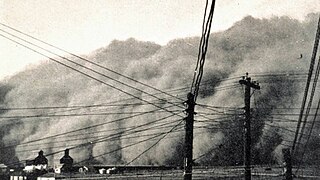Haboob

A haboob (Arabic: هَبوب, romanized: habūb, lit. 'blasting/drifting') is a type of intense dust storm carried on an atmospheric gravity current, also known as a weather front. Haboobs occur regularly in arid regions throughout the world.
Description
During thunderstorm formation, winds move in a direction opposite to the storm's travel, and they move from all directions into the thunderstorm. When the storm collapses, and begins to release precipitation, wind directions reverse, gusting outward from the storm and generally gusting the strongest in the direction of the storm's travel.[1][2][3] Haboobs can also form when a strong thunderstorm weakens rapidly, and releases a microburst.
When this downdraft of cold air, or downburst, reaches the ground, it blows dry, loose silt and clay (collectively, dust) up from the desert, creating a wall of sediment that precedes the storm cloud. This wall of dust can be up to 100 km (62 mi) wide and several kilometers in elevation. At their strongest, haboob winds often travel at 35–100 km/h (22–62 mph), and they may approach with little or no warning. Often rain does not appear at ground level as it evaporates in the hot, dry air (a phenomenon known as virga). The evaporation cools the rushing air even further and accelerates it. Occasionally, when the rain does persist, it can contain a considerable quantity of dust. Severe cases are called mud storms. Eye and respiratory system protection are advisable for anyone who must be outside during a haboob. Moving to shelter is highly advised during a strong event.
Occurrence
Middle East
Haboobs have been observed in the Sahara desert (typically Sudan, where they were named and described), as well as across the Arabian Peninsula, throughout Kuwait, and in the most arid regions of Iraq.[4] Haboob winds in the Arabian Peninsula, Iraq, Kuwait are frequently created by the collapse of a thunderstorm.
North Africa
African haboobs result from the northward summer shift of the inter-tropical front into North Africa, bringing moisture from the Gulf of Guinea.
Australia
Haboobs in Australia may be frequently associated with cold fronts. The deserts of Central Australia, especially near Alice Springs, are particularly prone to haboobs, with sand and debris reaching several kilometers into the sky and leaving up to 30 centimetres (1 ft) of sand in the haboob's path.
North America
As with haboobs in the Arabian Peninsula, Iraq and Kuwait, haboob occurrences in North America are often created by the collapse of a thunderstorm.
The arid and semiarid regions of North America—in fact, any dry region—may experience haboobs. In North America, the most common terms for these events are either dust storm or sandstorm. In the U.S., they frequently occur in the deserts of Arizona, including around the cities of Yuma and Phoenix;[5][6] in New Mexico, including Albuquerque; in eastern California, and in Texas.[7]
Gallery
-
A haboob closes in on Nyala Airport
-
Dust Bowl-era haboob approaching Spearman, Texas, on 14 April 1935
-
Haboob blowing into Ahwatukee, Phoenix, Arizona, on 22 August 2003
-
A massive haboob is close to enveloping Al Asad Airbase, Iraq, just before nightfall on 27 April 2005
-
A haboob approaches Taji, Iraq, in 2006
See also
|
|
References
- ^ Farquharson, J. S. (1937). "Haboobs and instability in the sudan". Quarterly Journal of the Royal Meteorological Society. 63 (271): 393–414. Bibcode:1937QJRMS..63..393F. doi:10.1002/qj.49706327111.
- ^ Lawson, T. J. (1971). "Haboob Structure at Khartoum". Weather. 26 (3): 105–112. Bibcode:1971Wthr...26..105L. doi:10.1002/j.1477-8696.1971.tb07402.x.
- ^ Membery, D. A. (1985). "A Gravity-Wave Haboob?". Weather. 40 (7): 214–221. Bibcode:1985Wthr...40..214M. doi:10.1002/j.1477-8696.1985.tb06877.x.
- ^ Sutton, L. J. (1925). "Haboobs". Quarterly Journal of the Royal Meteorological Society. 51 (213): 25–30. Bibcode:1925QJRMS..51...25S. doi:10.1002/qj.49705121305.
- ^ Idso, S. B.; Ingram, R. S.; Pritchard, J. M. (1972). "An American Haboob". Bulletin of the American Meteorological Society. 53 (10): 930–935. Bibcode:1972BAMS...53..930I. doi:10.1175/1520-0477(1972)053<0930:AAH>2.0.CO;2.
- ^ Idso, Carolyn W. (1973). "Haboobs in Arizona". Weather. 28 (4): 154–155. Bibcode:1973Wthr...28..154I. doi:10.1002/j.1477-8696.1973.tb02253.x.
- ^ Chen, W.; Fryrear, D. W. (2002). "Sedimentary characteristics of a haboob dust storm". Atmospheric Research. 61 (1): 75–85. Bibcode:2002AtmRe..61...75C. doi:10.1016/S0169-8095(01)00092-8.
External links
- Haboob Photos @ HikeArizona.COM
- Haboobs, Arizona Department of Transportation.
- The Bibliography of Aeolian Research
- Haboob on Winds of the World
- Short Video of the 5 July 2011 Arizona Haboob (Flash Video software or a web browser supporting H.264/MPEG-4 AVC is necessary to see the content) on YouTube
- Time-lapse video of the 5 July 2011 Arizona Haboob





